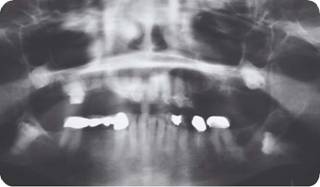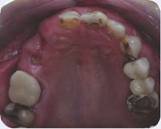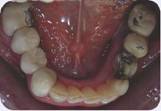
Prognostic indicators for strategic extractions in a full mouth rehabilitation
With increasing emphasis on evidence-based practice, the decision-making for an appropriate comprehensive treatment plan is a complicated process due to many confounding factors. In this chapter, various treatment approaches are discussed for the rehabilitation of partially edentulous arches.
CASE STORY
A 45-year-old female patient presents not having been to a dentist for more than 5 years. Her chief complaint was “I would like to have better looking teeth.” The patient has been receiving sporadic dental treatments during the past 10 years. She stated that the teeth were lost due to extensive decay resulting in abscesses requiring extractions.
LEARNING GOALS AND OBJECTIVES
- To plan treatment for a full mouth rehabilitation on severely compromised dentition
- Strategic extraction
- Prognostic determinants for periodontal stability
- Survival rate of endodontically treated teeth
- Survival of fixed partial dentures
- Prosthetic complications of implant-supported/ retained prostheses
Medical History
- No contributory findings noted
Dental History
- Sporadic dental treatments during the past 10 years
Clinical Findings/Problem List
- Partially edentulous maxilla: missing maxillary right first premolar, canine, lateral incisor (5, 6, and 7)
- Partially edentulous mandible: missing mandibular right first and second premolars (28 and 29)
- Multiple defective existing restorations
- Presence of clinical mobility on maxillary right first molar (3) with recurrent caries
- Grade 2 furcation involvement on mandibular left first molar (19)
- Poor oral hygiene
- Moderate to severe plaque and calculus accumulation
- Presence of endodontically treated teeth with recurrent caries
Radiographic Findings
Figure 4: Radiograph after extractions of 2, 5, 6, 7, 12 to 15.

Diagnosis
- Maxillary and mandibular partial edentulism
- Defective existing restorations
- Recurrent caries
- Chronic generalized moderate periodontitis
Clinical Decision-Making Determining Factors
- The severity of bleeding on probing, probing depth, and tooth mobility are important in determining clinical parameters. However, these parameters are only valid predictors for teeth with good prognoses. (Nordland, Garrett et al. 1987; Badersten, Nilvrus et al. 1990; Claffey and Egelberg 1995).
- Several retrospective studies suggested furcation involvement was one of the main reasons for tooth loss. In a review of therapeutic outcomes, retention rates of furcated teeth ranged from 43-98%, suggesting that the actual retention rate is better than the long-term predicted prognosis (Hirschfeld and Wasserman 1978; McFall 1982; Becker, Berg et al. 1984).
- In a systematic review of the endodontic literature, the survival rate after endodontic treatment followed by coronal restoration ranged from 81.2-100% over 3-25 years (Iqbal 2007).
- Endodontic retreatment can significantly reduce the 97% success rate seen with initial endodontic therapy.
- Surgical ret/>
Stay updated, free dental videos. Join our Telegram channel

VIDEdental - Online dental courses





